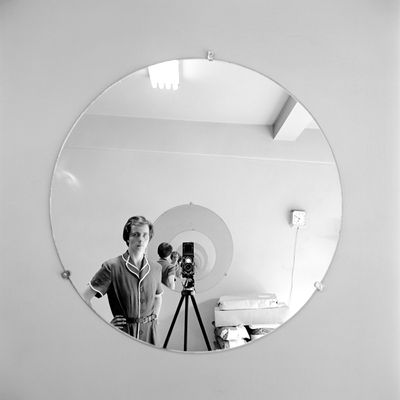
The story is almost too good to be true. One of the greatest photographers of the 20th century, among the most omnivorous and hyperperceptive visionaries ever to use a camera, was entirely unknown before 2007. ThatÔÇÖs when a young Chicagoan named John Maloof went looking for images to illustrate a history of his neighborhood that he was writing and bought a box of unprinted negatives at an auction for $380. It held between 30,000 and 40,000 frames, shot from the 1950s through the 1970s, by a woman named Vivian Maier. The photographs werenÔÇÖt useful for his project, but a new world opened and a star was born. The odds against this exact buyerÔÇÖs walking across the street to this auction and stumbling on these photographs, then having the wherewithal and dedication to save and piece together the life story of this extraordinary forgotten woman, borders on the providential.
Now, in the absorbing 83-minute documentary Finding Vivian Maier, Maloof and co-director Charlie Siskel peel back her layers, allowing us to see where her creative universe came from, how she functioned, what she made. Much of the film is made up of straightforward interviews with her former employers interspersed with wonderful visuals: Maloof laying out all of MaierÔÇÖs stuff on the floor or describing his attempts to track her down, and a great array of her amazing pictures. Working as a nanny in the Chicago area, Maier found positions where she could be taken care of so that she could take care of her art. She was a servant of her talent, compelled to use her servitude to make what she needed to make.
Many will find her story compelling and filled with pathos. Born in New York in 1926, she started taking photos in 1949, with a Brownie. Three years later she acquired a state-of-the-art Rolleiflex and really started bearing down on her vision, shooting everywhere she went, mainly on the street, but also in stores, at the beach, on ferry boats, in her room, of kids, herself, and never stopped making photographs until her death in 2009. Almost nobody knew. She was a hoarder, filling her rooms with mountains of stuff. Interviewers describe an odd, intimidating, almost Asperger personality, someone who walked rigidly and swung her arms as if marching. She took no guff and would bring the kids she tended anywhere ÔÇö including, at least once, to a slaughterhouse, where she photographed them. A tall, pretty, but unglamorous woman in neutral and often outdated clothes, she always wore her camera around her neck, even when caring for her charges. She traveled the world alone, taking pictures everywhere she went, and also made audio recordings and shot movie film. In 1976, she switched from black-and-white film to color, more or less permanently. She rarely printed her images, carefully storing them instead. She never exhibited them.
Maloof has dedicated himself to reassembling as much of her work as he can, and since he bought that initial lot at auction, he has amassed almost 150,000 negatives, proving that Maier was an astonishingly productive, driven artist. SheÔÇÖs also a great one. Her pictures can stand alongside of and sometimes recall those of Cartier-Bresson, Lisette Model, Robert Frank, Andr├® Kertesz, Diane Arbus, Richard Avedon, Walker Evans, Gary Winogrand, Richard Avedon, and Weegee.
That Rolleiflex ÔÇö a twin-lens reflex camera ÔÇö helped unlock her power as an artist. As the photographer Joel Meyerowitz notes in the film, it doesnÔÇÖt require the photographer to raise the camera to her face in a dramatic, obvious, intimidating gesture, the way a single-lens reflex does. Instead, the Rolleiflex user looks down into the top of the camera, held at waist level, in order to focus and frame. Maier thus could get close to her subjects without their knowing it, unobtrusively, without any aggressive motion. This explains some of the frame-filling closeness of many of her subjects. The RolleiflexÔÇÖs square format also negates any top-to-bottom hierarchical left-to-right narrative composition. ThereÔÇÖs no sense of landscape or portrait format; instead we get an oddly artificial, always formal square view of the world. This reinforces the directness, intensity, and insistence of MaierÔÇÖs vision. (And of Diane ArbusÔÇÖs, by the way: She too used a Rolleiflex, among other cameras.)
MaierÔÇÖs world is simultaneously monumental and humdrum. She sometimes seems to lie in wait for subjects, catching them as they get off buses, come up subway steps, walk out of shops. She gets people in mid-stride but makes them somehow classical in stature, not fleeting, but whole, self-evident, mortal. Bells go off when you look at her pictures; you become witness to something big. Proust talked of ÔÇ£the apogee of the particular.ÔÇØ ThatÔÇÖs here. This gives MaierÔÇÖs work psychological and philosophical force, something deeply observant. At the same time, she also has an outsiderÔÇÖs view of the world. SheÔÇÖs one who watches, silently observes, is alert to the tiniest disturbance in the visual or psychic field. She gives us a vendor nodding off in his newsstand, framed by magazines and newspapers, giving the dream to a sleeper. The valor of being alive comes into focus.
The TimesÔÇÖ┬áotherwise excellent Manohla Dargis churlishly labeled this documentary ÔÇ£a feature-length advertisement for Mr. MaloofÔÇÖs commercial venture as the principal owner of her work.ÔÇØ This sort of cynical snappishness is cropping up a lot in many criticsÔÇÖ work of late ÔÇö the idea that if thereÔÇÖs any profit involved, the work must be less pure, less good, more suspect. Whatever: I love this advertisement. Besides: Maloof tried to get MoMA interested in MaierÔÇÖs work. In the film, he shows us and reads the perfunctory rejection letter he got from the museum. He was on his own. No one else wanted to take on the responsibility of unearthing and bringing to light this truly great artist. History will be grateful to him, and no one should look back cynically at his commitment to Vivian Maier.

